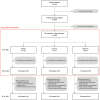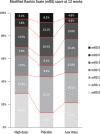Nelonemdaz for Patients With Acute Ischemic Stroke Undergoing Endovascular Reperfusion Therapy: A Randomized Phase II Trial
- PMID: 36065810
- PMCID: PMC9586831
- DOI: 10.1161/STROKEAHA.122.039649
Nelonemdaz for Patients With Acute Ischemic Stroke Undergoing Endovascular Reperfusion Therapy: A Randomized Phase II Trial
Abstract
Background: Nelonemdaz is a multitarget neuroprotectant that selectively blocks N-methyl-D-aspartate receptors and scavenges free radicals, as proven in preclinical ischemia-reperfusion studies. We aimed to evaluate the safety and efficacy of nelonemdaz in patients with acute ischemic stroke receiving endovascular reperfusion therapy.
Methods: This phase II randomized trial involved participants with large-artery occlusion in the anterior circulation at baseline who received endovascular reperfusion therapy <8 hours from symptom onset at 7 referral stroke centers in South Korea between October 29, 2016, and June 1, 2020. Two hundred thirteen patients were screened and 209 patients were randomly assigned at a 1:1:1 ratio using a computer-generated randomization system. Patients were divided into 3 groups based on the medication received-placebo, low-dose (2750 mg) nelonemdaz, and high-dose (5250 mg) nelonemdaz. The primary outcome was the proportion of patients with modified Rankin Scale scores of 0-2 at 12 weeks.
Results: Two hundred eight patients were assigned to the placebo (n=70), low-dose (n=71), and high-dose (n=67) groups. The groups had similar baseline characteristics. The primary outcome was achieved in 183 patients, and it did not differ among the groups (33/61 [54.1%], 40/65 [61.5%], and 36/57 [63.2%] patients; P=0.5578). The common odds ratio (90% CI) indicating a favorable shift in the modified Rankin Scale scores at 12 weeks was 1.55 (0.92-2.60) between the placebo and low-dose groups and 1.61 (0.94-2.76) between the placebo and high-dose groups. No serious adverse events were reported.
Conclusions: The study arms showed no significant difference in the proportion of patients achieving modified Rankin Scale scores of 0-2 at 12 weeks. Nevertheless, nelonemdaz-treated patients showed a favorable tendency toward achieving these scores at 12 weeks, without serious adverse effects. Thus, a large-scale phase III trial is warranted.
Registration: URL: https://clinicaltrials.gov; Unique identifier: NCT02831088.
Keywords: cerebral infarction; ischemic stroke; neuroprotective agent; odds ratio; reperfusion.
Figures



References
-
- Gwag BJ, Lee YA, Ko SY, Lee MJ, Im DS, Yun BS, Lim HR, Park SM, Byun HY, Son SJ, et al. . Marked prevention of ischemic brain injury by Neu2000, an NMDA antagonist and antioxidant derived from aspirin and sulfasalazine. J Cereb Blood Flow Metab. 2007;27:1142–1151. doi: 10.1038/sj.jcbfm.9600418 - PubMed
-
- Gwag BJ, Koh JY, DeMaro JA, Ying HS, Jacquin M, Choi DW. Slowly triggered excitotoxicity occurs by necrosis in cortical cultures. Neuroscience. 1997;77:393–401. doi: 10.1016/s0306-4522(96)00473-3 - PubMed
-
- Visavadiya NP, McEwen ML, Pandya JD, Sullivan PG, Gwag BJ, Springer JE. Antioxidant properties of Neu2000 on mitochondrial free radicals and oxidative damage. Toxicol In Vitro. 2013;27:788–797. doi: 10.1016/j.tiv.2012.12.011 - PubMed
-
- Goyal M, Menon BK, van Zwam WH, Dippel DW, Mitchell PJ, Demchuk AM, Dávalos A, Majoie CB, van der Lugt A, de Miquel MA, et al. ; HERMES collaborators. Endovascular thrombectomy after large-vessel ischaemic stroke: a meta-analysis of individual patient data from five randomised trials. Lancet. 2016;387:1723–1731. doi: 10.1016/S0140-6736(16)00163-X - PubMed
-
- Badhiwala JH, Nassiri F, Alhazzani W, Selim MH, Farrokhyar F, Spears J, Kulkarni AV, Singh S, Alqahtani A, Rochwerg B, et al. . Endovascular thrombectomy for acute ischemic stroke: a meta-analysis. JAMA. 2015;314:1832–1843. doi: 10.1001/jama.2015.13767 - PubMed

